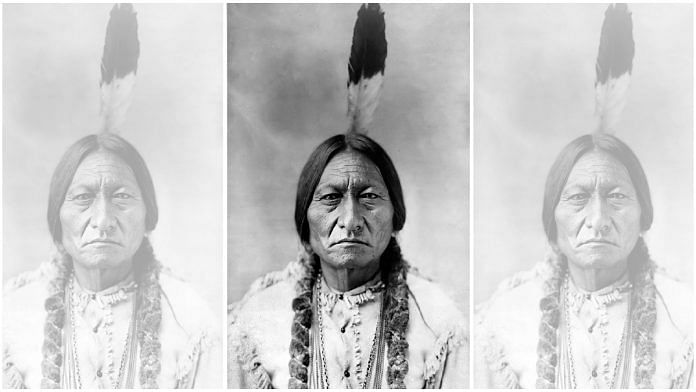New Delhi: Scientists have confirmed a US man’s claim to be the great-grandson of the legendary Sitting Bull using DNA extracted from the late Native American leader’s lock of hair.
Sitting Bull is known to have led 1,500 Lakota warriors at the Battle of the Little Bighorn in 1876, which symbolises the resistance of Native Americans to the white man’s government. Bull was assassinated in 1890.
The confirmation was made possible using a new method to analyse family lineages using ancient DNA fragments, developed by a team of scientists the University of Cambridge and Lundbeck Foundation GeoGenetics Centre.
DNA from hair was compared to DNA samples from Ernie Lapointe and other members of the native American tribe called Lakota Sioux. The resulting match confirms that Lapointe is Sitting Bull’s great-grandson, and his closest living descendant. Read more
Wildfires raged in Antarctica 75 million years ago
A new study revealed that Antarctica, currently a frigid desert, suffered raging wildfires 75 million years ago when dinosaurs still roamed the Earth.
During the late Cretaceous period — between 100 million to 66 million years ago — Antarctica’s James Ross Island was warm enough to be home to a forest of conifers, ferns and flowering plants, as well as dinosaurs.
Much like warm climates trigger wildfires today, the ancient fires burned parts of these forests to the ground. The leftover charcoal remnants offered scientists an opportunity to delve into the South Pole’s warm, green past.
This marks the first time that paleo-fires have been documented on James Ross Island, a part of the Antarctic Peninsula that now sits below South America.
The discovery adds evidence that spontaneous fires were common in Antarctica about 84 million to 72 million years ago.
For the new work, an international team of scientists analyzed fossils collected during a 2015-2016 expedition to the northeastern part of James Ross Island. These fossils contained fragments of plants that looked like charcoal residue, which had weathered away over the past tens of millions of years. Read more
Giant sea scorpion fossil dating back to 400 million years ago found
Scientists from China have discovered the fossil remains of a giant sea scorpion measuring about a metre long that lived over 400 million years ago.
The creature looks like an enlarged scorpion, with its body decorated with needle-like spikes and a tail that resembles a serrated knife.
Dubbed Terropterus xiushanensis, the giant swimming beast likely used its limbs to capture prey. The arachnid is the first of its kind to be discovered near the region of southern China and is the oldest known member of the fearsome Mixopteridae clan.
Between 443.8 million years ago and 419.2 million years ago, this area was known as Gondwana. The new fossil could further our understanding of these vicious sea dwellers’ diversity and reach. Read more
Scientists convert bioplastics into fertilisers
Researchers have found a way to convert certain classes of plastics into fertilizers.
The team at Tokyo Institute of Technology created a new environmentally friendly process. It uses plastics produced using biomass and recycles them back into fertilizers.
The team focused on bio-based polycarbonate or PIC that has garnered much attention as an alternative to petroleum-based polycarbonates. PIC is produced using a non-toxic material derived from glucose called isosorbide (ISB).
As a proof-of-concept that all PIC degradation products can be directly used as a fertilizer, the team conducted plant growth experiments. They found that plants treated with all PIC degradation products grew better than plants treated with just urea. Read more
Why great white sharks bite humans
Scientists have revealed new insights into why great white sharks bite humans. By using a simulated ‘shark vision’ model on swimming patterns of humans, seals and sea-lions, researchers from Macquarie University showed that humans of surfboards look like baby seals for sharks.
According to the team, surfers are the highest-risk group for fatal shark bites, especially by juvenile white sharks.
Great white sharks are also called white sharks and together with bull and tiger sharks, they account for by far the most bites on humans.
The team has been working for years to understand how sharks see, by exploring the neuroscience of white sharks’ visual systems.
The team compared underwater video of rectangular floats, seals and sea lions swimming, humans swimming different strokes and humans paddling on variously sized surfboards in a large aquarium at Taronga Zoo, with both stationary and traveling cameras pointed toward the water surface.
Smaller surfboards were harder to distinguish from the marine mammals, which is why they are targeted by white sharks. .
Most sharks are likely completely colour-blind, and the main visual cue for white sharks is the silhouette shape, so colours on boards and wetsuits are unlikely to change sharks’ impressions of floating humans.
However, the researchers are now exploring other ways to change the way that sharks perceive different silhouettes, including the judicious use of LED lights. Read more
(Edited by Paramita Ghosh)



